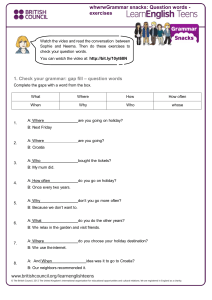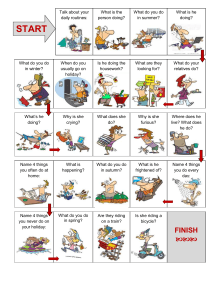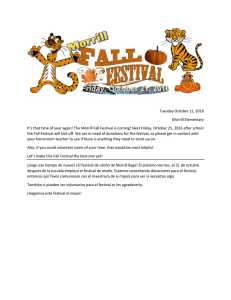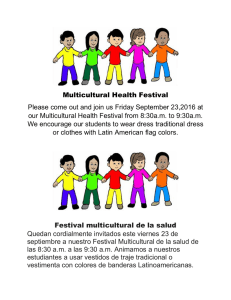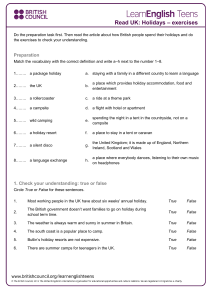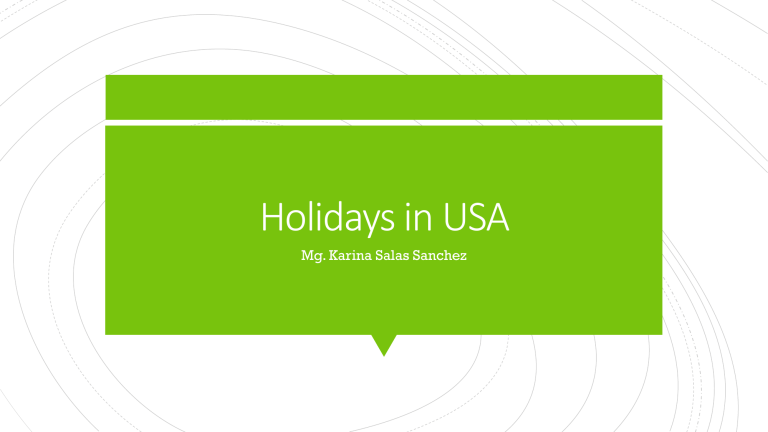
Holidays in USA Mg. Karina Salas Sanchez New Year’s celebrations actually begin the night of New Year’s Day: Jan. 1 December 31 with parties, concerts, fireworks and special events of all kinds. The day is marked in many American towns and cities with parades and U.S.- style football games. New Year’s Day abounds with rituals and superstitions brought to the United States by immigrants. Immigrants of various nationalities believed that loud noises — firecrackers or gunfire — drive away the bad spirits of the past year and ensure a new year free of evil. “ New York City famously counts down to the midnight hour in Times Square, where thousands gather to watch a faceted crystal ball drop at the appointed hour. The tradition dates from 1907. Dr. Martin Luther King Jr.(January 15, 1929 – April 4, Martin Luther King Jr. Day: Third Monday in January 1968) is best known for his role in advancing civil rights using nonviolent civil disobedience. King has become a national icon in the history of American progressivism. King spoke before more than 200,000 regarding the challenges African Americans face. His “I Have a Dream” speech has gone down in many history books as one of the greatest speeches ever given. February 22 was celebrated as a holiday by 19thcentury Americans. At least a dozen states officially celebrate the third Monday in February as “Washington and Lincoln’s Birthday,” and another dozen states call it “Presidents Day.” Presidents’ Day: Third Monday in February Each year in the United States, Americans observe the Memorial Day: Last Monday in May Federal holiday, Memorial Day, the last Monday in May. It honors and remembers all men and women who have died while serving in the United States Armed Forces. (known as “Decoration Day”) honoring the lives lost in that conflict, often by decorating their graves with flowers. The Independence Day holiday commemorates the adoption of the Declaration of Independence by the Second Continental Congress on July 4, 1776. Today, most citizens celebrate in much the same ways Independenc e Day: July 4 as Americans did during the 18th century, with parades, picnics, neighborhood parties, outdoor concerts, sporting events and fireworks displays at night. First observed in New York City in September 1882, the Labor Day holiday commemorates the contributions of working men and women. Many Americans celebrate Labor Day with parades, Labor Day: First Monday in September picnics and parties – festivities, followed by a festival for the recreation and amusement of the workers and their families. This holiday commemorates Christopher Columbus’s first landing in the Americas on October 12, 1492. During the anniversary of 1892, teachers, preachers, Columbus Day: Second Monday in October poets, and politicians used the day to teach ideals of patriotism. These patriotic teachings were framed around themes of support for war, citizenship boundaries, the importance of loyalty to the nation, and celebrating social progress. Veterans Day on November 11th honors military veterans who served in the United States Armed Forces. Veterans Day is not to be confused with Memorial Day or Armed Forces Day. Veterans Day celebrates all United States military veterans. However, Memorial Day is set aside for remembering the men and women who died while serving. Additionally, Armed Forces Day recognizes the men and women currently serving in the United States military. In 1621, the Plymouth colonists and Wampanoag Indians shared an autumn harvest feast that many acknowledge today as one of the first Thanksgiving celebrations in the colonies. Thanksgiving: Fourth Thursday in November The observance is a time when families and friends gather and give thanks for many reasons, each often as different as each person who gathers around the table. The pilgrims sailed to America from England in 1620. The Indians taught the Pilgrims how to survive(how to plant, Hunt, etc). The pilgrims in response to that decided to Celebrate with Thanksgiving feast. Thanksgiving: Fourth Thursday in November Most Christians celebrate the birth of Jesus of Nazareth on December Christmas Day: Dec. 25 25. Before the 19th century, many Americans worked on Christmas, but in the industrial era the holiday also began to honor universal values such as home, children and family life, and to incorporate secular customs like exchanging gifts and cards, and the decoration of evergreen trees. Congress proclaimed Christmas a federal holiday in 1870. In 1999, a federal court acknowledged the secular aspects of Christmas in rejecting a claim that the holiday impermissibly endorsed and furthered a particular religious belief. Holidays in UK 1 January: New Year’s Day - On New Year’s Eve (31 December) it’s traditional to celebrate midnight. There are parties across the country, with Edinburgh’s ‘Hogmany’ being one of the biggest. New Year’s Day is a public holiday so expect the celebrations to last well into the night! Hogmanay First footing is when you visit friends or family immediately after midnight in order to become the first person to visit them and go into their house in the new year. Your very first foot - the first person to visit you in the new year – should traditionally be a tall, dark-haired man. That is said to date back to the Viking invasions, as Vikings were typically fairer haired, so the arrival of a blonde man could have meant imminent danger! First footers also traditionally bring a lump of coal to ensure the house remains warm in the coming months. St. Patrick’s Day is celebrated annually on March 17, the anniversary of his death in the fifth century. St. Patrick’s Day 2022 will take place on Thursday, March 17. Saint Patrick, who lived during the fifth century, is the patron saint of Ireland and its national apostle. Born in Roman Britain, he was kidnapped and brought to Ireland as a slave at 16. He later escaped, but returned to Ireland and was credited with bringing Christianity to its people. Perhaps the most well-known legend of St. Patrick is that he explained the Holy Trinity (Father, Son and Holy Spirit) using the three leaves of a native Irish clover, the shamrock. 21 June: Summer solstice The summer solstice marks the longest day and the shortest night of the year, although the sun's position remains in pretty much the same place for a few days on either side. It is celebrated all over the UK in a diverse variety of ways. Perhaps the most famous is the celebration at the ancient monument of Stonehenge, where around 10,000 people gather to watch the sunrise. Late June: Glastonbury festival - Summer in the UK means music festival time. With its 175,000 revellers Glastonbury is the largest and most iconic. But from Wales’ Festival No.6 and Scotland’s T in the Park, to the new grass-roots festivals emerging across the country, there are plenty of opportunities to enjoy the festival season. https://www.glastonburyfestivals.co.uk/ August: Edinburgh Festival Fringe - ‘The Fringe’ features over 50,000 performances and more than 3,000 shows, over three weeks every August. As the world’s biggest arts festival it’s the place to go for stand-up comedy, dance, theatre, art exhibitions, circus, spoken word, opera and more. The Fringe began in 1947, concurrently with the Edinburgh International Festival, an invitation-only festival. In that first year eight theatre troupes who had not been invited to perform arrived on the scene, arranged a performance space, and put on their shows during the run of the official festival. Their efforts were fruitful, and the following year even more unofficial participants were present. https://www.edfringe.com/ London’s biggest street party, as the streets of west London are filled with Caribbean colours, music and flavours during Notting Hill Carnival. Carnival is a celebration of freedom and Caribbean culture, with an iconic parade showcasing the best of mas, soca, calypso, steel bands and soundsystems. https://nhcarnival.org/ The year was 1605 and some English Catholics were angry because King James I was treating them badly. In November of that year, a group of men made a plan to blow up the Houses of Parliament in London. An enormous explosion was planned for 5 November. This was the day that the king was due to open Parliament. The plan became known as the ‘Gunpowder Plot’ and the leader of the group was called Guy Fawkes. The men put 36 barrels of gunpowder in the Houses of Parliament and waited for the king to arrive. The group decided that Guy Fawkes should light the gunpowder and cause the explosion. Did they succeed? No, they didn’t. The police found the gunpowder before it exploded and they caught all the men involved in the plot. The men were tortured and killed. To celebrate his survival, King James ordered the people of England to have a bonfire on the night of 5 November. One idea is that December 26 was the day centuries Boxing Day ago when lords of the manor and aristocrats typically distributed “Christmas boxes” often filled with small gifts, money and leftovers from Christmas dinner to their household servants and employees, who were required to work on December 25, in recognition of good service throughout the year. These boxes were, in essence, holiday bonuses. Another popular theory is that the Boxing Day moniker arose from the alms boxes that were placed in churches during the Advent season for the collection of monetary donations from parishioners
